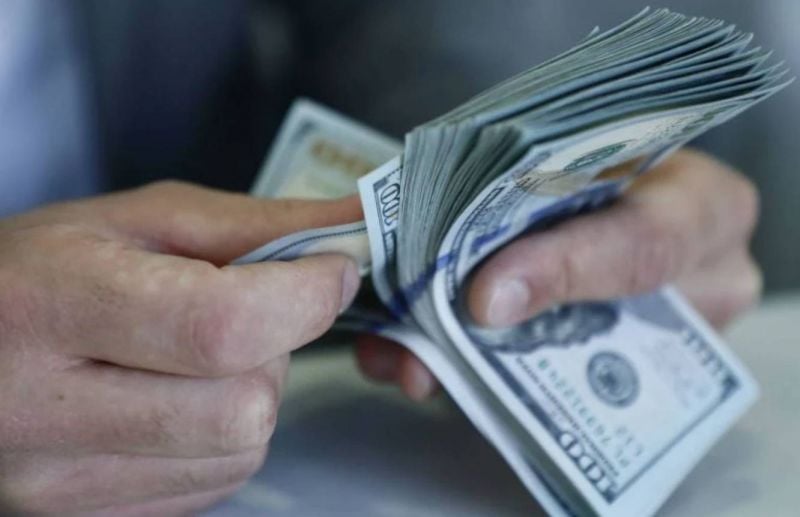
Nearly half of payments in supermarkets are now made in dollars. (Credit: Marc Fayad)
Before the 2019 crisis, the currency with which one chose to pay did not matter much to the Lebanese. The exchange rate, set at LL1,500 to the dollar, was known to all. Daily transactions were carried out in either currency and sometimes a mix between the two. There was no real preference for one over the other.
Attitudes towards currency changed when Lebanon plunged into a deflationary spiral that led to an unprecedented economic crisis which has been ongoing for over three years. During these three turbulent years, the lira lost nearly 98 percent of its value, crossing the LL100,000 to the dollar threshold last month.
Today, the Lebanese population is divided between those who earn in lira and those who earn in dollars. Some people have cash savings, extract trickle withdrawals based on BDL’s Sayrafa exchange rate of their blocked dollars, or rely on money transfers from abroad. Many people are left wondering whether it still makes sense to exchange their dollars into lira to make their purchases.
Sarah Hariri Haykal, economist and professor at the University of St. Joseph told L’Orient-Le Jour that it is sometimes wiser on an individual level to pay directly in dollars, in order to be sure not to lose on exchange. While there has been an official exchange rate of LL15,000 per dollar since Feb. 1, 2023, small daily transactions charged at the parallel market rate, which fluctuates daily and is now slightly below LL100,000 to the dollar.
“When you want to buy something in Lebanon, it is first advisable to see what exchange rate is applied by the merchant. If you exchanged your dollars into lira at a lower rate than the one displayed by the merchant, your purchase will cost you more if you pay in lira. In this case, it is better to pay in dollars,” said Haykal.
Favoring the dollar over the lira
Hotels and restaurants prefer to be paid in dollars since they pay most of their expenses in the currency. “We pay our suppliers, for our goods and some of our employees in dollars. The payment of the bill with the precious greenback by the customer allows us, as restaurant owners, to secure an income in a stable currency unlike the lira,” said Maya Noun, secretary-general of the syndicate of restaurant owners in Lebanon.
When the exchange rate applied by the merchant equals that of the market, it is up to the consumer to decide how to pay. This is particularly the case in supermarkets, where since the beginning of March, prices have been officially displayed in dollars. In supermarkets, it is possible to pay in lira at the market rate displayed by the shop. Since this decision came into force, the president of the union of supermarket owners Nabil Fahed noted that 40 to 60 percent of payments are now made in dollars, depending on the location of the supermarket.
This increase in dollar payments in shops is also felt at the country’s currency exchange offices. According to the syndicate of money changers, the share of dollars converted into Lebanese lira has decreased in recent months, while the exchange of smaller dollar notes ($10, $20 and $50) has increased.
“When I make my payments in dollars, I always make sure to have $10 or $20 bills, because merchants tend to give change in lira instead of dollars and according to the exchange rate they determine themselves. The lira is now used as a small change for the dollar,” said Tia Rahy, a young student who makes sure to carry smaller bills when going out with friends.
Lebanese lira bills still present in wallets
While the Lebanese lira is no longer considered a stable reserve currency, it is still used in daily transactions by many people, notably those who do not have access to dollars.
This is particularly true of mobile phone top-ups, which are paid for in lira at the Sayrafa rate, recently set at LL87,000 to the dollar. On the other hand, some shopkeepers or cab drivers still prefer to be paid in lira because they find it profitable. This is what Nadim, a salesman in a small mini-market in Hazmieh, said. He still asks his customers to pay in lira. “Thanks to the fluctuations of the national currency, I can exchange my liras for more dollars. For example, yesterday, instead of selling this packet of chips for $1, I sold it for LL100,000. Today, the rate is LL97,000 to the dollar. So, if I sell the LL100,000 from yesterday, I get $1.03. That’s not much on small amounts, but on big amounts it is,” said Nadim.
According to Haykal, choosing to pay in lira is more in the interest of the individual than the common good, since it contributes to the national currency’s devaluation. “We always had the possibility to pay in dollars or lira in Lebanon because the currency was stable. Today, no one has confidence in the national currency, which leads to a decrease in demand for lira and contributes to its depreciation,” said the economist. Eventually, Haykal fears that the national economy would become entirely dollarized if people give up using the lira, although she noted that some Lebanese “make a point of honor to paying in lira” to avoid letting this happen.
This article was originally published in French in L'Orient-Le Jour. Translation by Joelle El Khoury.